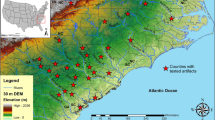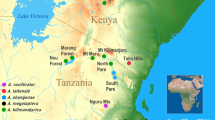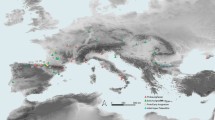Abstract
Little evidence exists for human occupation of the Mediterranean Islands before ∼9,000 yr before present (BP)1, and extinct Pleistocene fauna rarely have been associated with archaeological materials from the region. Intriguing claims, however, have been presented for the early occupation of Mallorca2 and Sardinia3. Although it has been suggested that Cyprus may have been inhabited as early as the Palaeolithic, this has not been substantiated and the consensus of opinion is that the initial inhabitation was by Neolithic peoples ∼9,000 yr ago4,5. But new evidence from Akrotiri Aetokremnos ('Eagle's Cliff or 'Site E') suggests an earlier occupation. This site also contains evidence for the association of cultural remains with extinct pygmy hippopotamus (Phanourios minutus6). Although beds containing bones of the pygmy hippopotamus are known from Cyprus7,8, this species is generally believed to have gone extinct before man's presence on the island9. From my analysis, I tentatively conclude that Site E is the earliest archaeological site in Cyprus and that the Island was occupied by approximately 10,000 yr BP. Finally I suggest that the extinction of the pygmy hippopotamus on Cyprus may have been accelerated by the presence of man on the island.
This is a preview of subscription content, access via your institution
Access options
Subscribe to this journal
Receive 51 print issues and online access
$199.00 per year
only $3.90 per issue
Buy this article
- Purchase on SpringerLink
- Instant access to full article PDF
Prices may be subject to local taxes which are calculated during checkout
Similar content being viewed by others
References
Cherry, J. Proc. Prehist. Soc. 47, 41–68 (1981).
Burleigh, R. & J. Clutton-Brock J. Archaeol. Sci. 7, 385–388 (1980).
Sondaar, P., Sanges, M., Kotsakis, T. & deBoer, P. Geobios 19, 17–25 (1986).
Stanley-Price, N. Levant 9, 66–89 (1977).
Stanley-Price, N. World Archaeol. 9, 27–41 (1977).
Faure, M., Guerin, C. & Sondaar, P. Actes Symp. Paleont. Cuvier, Montebeliard 157–183 (1983).
Boekschoten, G. & Sondaar, P. Konikl. Nederl. Akad. van Weter 75, 306–338 (1972).
Bate, D. Geol. Mag. 5, 324–325 (1904).
Davis, S. The Archaeology of Animals (Yale, New Haven, 1987).
Reese, D. Earth Sci. 28, 63–69 (1975).
Reese, D. Expedition 17, 26–30 (1975).
Vogel, J., Fuls, A. & Visser, E. Radiocarbon 28, 1133–1172 (1986).
Vogel, J. & Waterbolk, H. Radiocarbon 5, 163–202 (1963).
Vogel, J. & Visser, E. Radiocarbon 23, 43–80 (1981).
Author information
Authors and Affiliations
Rights and permissions
About this article
Cite this article
Simmons, A. Extinct pygmy hippopotamus and early man in Cyprus. Nature 333, 554–557 (1988). https://doi.org/10.1038/333554a0
Received:
Accepted:
Issue date:
DOI: https://doi.org/10.1038/333554a0
This article is cited by
-
Pleistocene Water Crossings and Adaptive Flexibility Within the Homo Genus
Journal of Archaeological Research (2021)
-
The ‘Design’ of Mediterranean Landscapes: A Millennial Story of Humans and Ecological Systems during the Historic Period
Human Ecology (2006)
-
The prehistory of Cyprus: Problems and prospects
Journal of World Prehistory (1994)
-
Mammoths in miniature
Nature (1993)
-
Twilight of the pygmy hippos
Nature (1992)



